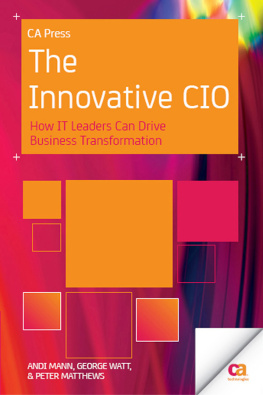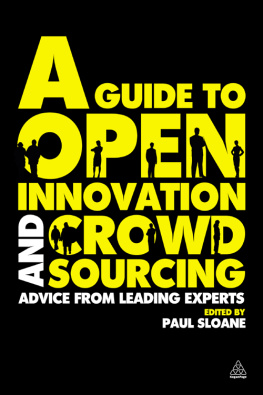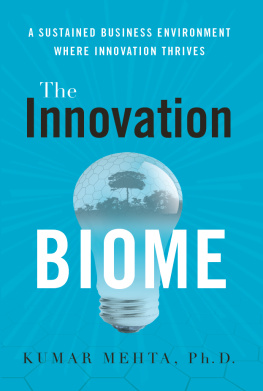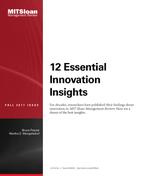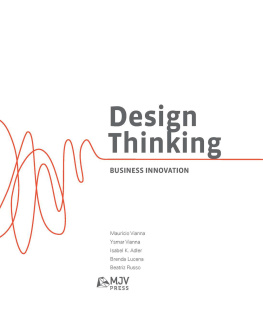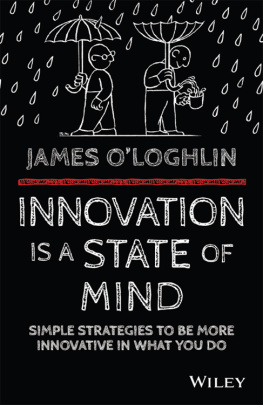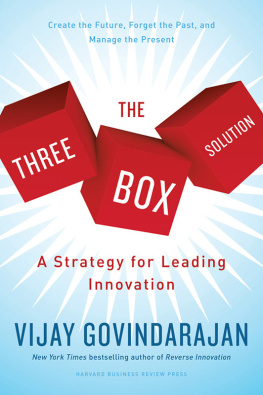Andi Mann - The Innovative CIO: How IT Leaders Can Drive Business Transformation
Here you can read online Andi Mann - The Innovative CIO: How IT Leaders Can Drive Business Transformation full text of the book (entire story) in english for free. Download pdf and epub, get meaning, cover and reviews about this ebook. year: 2012, publisher: Apress, genre: Business. Description of the work, (preface) as well as reviews are available. Best literature library LitArk.com created for fans of good reading and offers a wide selection of genres:
Romance novel
Science fiction
Adventure
Detective
Science
History
Home and family
Prose
Art
Politics
Computer
Non-fiction
Religion
Business
Children
Humor
Choose a favorite category and find really read worthwhile books. Enjoy immersion in the world of imagination, feel the emotions of the characters or learn something new for yourself, make an fascinating discovery.
- Book:The Innovative CIO: How IT Leaders Can Drive Business Transformation
- Author:
- Publisher:Apress
- Genre:
- Year:2012
- Rating:4 / 5
- Favourites:Add to favourites
- Your mark:
The Innovative CIO: How IT Leaders Can Drive Business Transformation: summary, description and annotation
We offer to read an annotation, description, summary or preface (depends on what the author of the book "The Innovative CIO: How IT Leaders Can Drive Business Transformation" wrote himself). If you haven't found the necessary information about the book — write in the comments, we will try to find it.
Does your organization fumble when it comes to innovation? The Innovative CIO presents a pragmatic guide to overcoming the 10 innovation killers within your company. --Dennis McCafferty CIO Insight, 1/23/2013 (www.cioinsight.com/it-management/innovation/slideshows/ten-ways-to-kill-innovation/)
Are you unwittingly stifling your employees entrepreneurial spirit? The Innovative CIO discusses innovation killers that could be holding back your small business or startup. --Paul Shread TIME/Business & Money, 1/29/2013 (business.time.com/2013/01/29/removing-barriers-to-innovation/#ixzz2JSrUlD3A)
The Chief Information Officers influence in the business organization has been waning for years. The rest of the C-suite has come to regard Information Technology as slow, costly, error-prone, boring, and unresponsive to business needs. This perception blinds company leaders to the critical value IT can deliver and threatens the competitive health and long-term survival of their enterprise.
The modern CIO must reassert the operational and strategic importance of technology to the enterprise and reintegrate it with every department and level of the business from boardroom to mailroom. IT leaders must design, sell, and implement a vigorous culture of IT competence and innovation that pervades the enterprise. The culture must be rooted in bidirectional exchange across organizations and C-level policies that drive technology innovation as the engine of business innovation.
The authors, international IT strategists and innovators, quantify the benefits and risks of IT innovation, survey and rank the myriad innovation opportunities from mature, new, and emerging technologies,and identify the organizational structures and processes that have been proven to deliver ongoing innovation. Buttressing their brief with dozens of case studies and specific examples, The Innovative CIO shows you how to:
- Take advantage of the IT and business innovation opportunities created by new and emerging technologies
- Shift IT innovation from afterthought to prime mover in strategic business planning
- Inject IT into the dynamic core of your organizations culture, training, structure, practice, and policy
* Grasp the business basics of new information technologies:
- Virtualization
- Cloud Computing
- Consumer-Driven IT
- Bring-Your-Own-Device
- Personalization
- Process Automation
- Mobile Computing
- E-Commerce
- Big Data and Analytics
- Social Networking
- E-Collaboration
* Judge the business opportunities presented by new and emerging technologies.
* Deploy new technologies to create and release new products.
* Use new technologies to penetrate and capture new markets.
* Harness new technologies to accelerate M&A time-to-value and add shareholder value.
* Apply new technologies to improve staff retention and productivity.
Who this book is forThe Innovative CIO targets all IT leadersnot only CIOs, but also VPs and directors of IT and IT operations, datacenter managers, and all other IT leaders who aspire to advance their careers as IT-providers to business leaders. This book serves secondarily as a guide to non-IT business leaders who are alert to the ways that IT can boost their abilities to innovate, to turbocharge their products, services, and processes, and to compete nimbly in fast-changing markets.
Table of Contents- Innovation Matters
- Stories from the Trenches
- Innovation Is Not the Only I
- Business Innovation vs. IT Innovation
- Pull and Push
- Opportunities to Innovate Today
- Innovating with Consumer-Driven IT
- Opportunities to Innovate Tomorrow
- Making Innovation Intentional
- Connecting IT Innovation with Business Value
- The Dirty Little Secrets of IT Innovation
- Whats Next for Me?
- Summary
Andi Mann: author's other books
Who wrote The Innovative CIO: How IT Leaders Can Drive Business Transformation? Find out the surname, the name of the author of the book and a list of all author's works by series.

